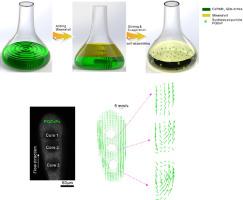Applied Materials Today ( IF 7.2 ) Pub Date : 2020-07-10 , DOI: 10.1016/j.apmt.2020.100736 Yi Huang , Lian Xiao , Lin Wang , Guiping Zhu , Shuai Yin , Shijia Cheng , Haoshuang Gu , Quanchao Du , Edwin Kok Lee Yeow , Teck Neng Wong , Handong Sun

|
Critical to both fundamental fluid physics and practical applications in microfluidics is the quantitative velocity field distribution for which micro particle image velocimetry (µ-PIV) has been a major measurement technology. Yet, the achievable imaging speed from a benchmark µ-PIV system is limited by the low fluorescence intensity of conventionally used fluorescent microparticles, restricting the capture of detailed flow field information in fast microfluidic processes. We tackle this hurdle by developing highly fluorescent micro particles from halide perovskite quantum dots by a generic one-step approach. This novel self-assemble method makes the fluorescent micro particles resistant to the aggregation induced quenching effect and ensures high luminescence efficiency, such that a record fluorescent imaging speed of 100,000 frames per second under the illumination of a low power continuous wave (CW) laser is achieved. Our finding not only offers the opportunity of affordable high performance µ-PIV but also allows for the seamless exploration of fast and complex microscale flow fields such as droplet dynamics and complex emulsion processes inaccessible by using conventional dye-based luminescent tracers. Besides the flow tracers in µ-PIV, such general and novel self-assembled micro particles may also find far reaching applications in other imaging related venues.
中文翻译:

通过基于金属卤化物钙钛矿的微粒实现对微流体中快速复杂流场的无缝研究
定量速度场分布对于基本流体物理学和微流体学中的实际应用都至关重要,对于该速度场分布,微粒图像测速法(µ-PIV)已成为主要的测量技术。然而,基准的µ-PIV系统可实现的成像速度受到常规使用的荧光微粒的低荧光强度的限制,从而限制了在快速微流体过程中捕获详细的流场信息。我们通过通用的一步法,从卤化钙钛矿量子点中开发出高度荧光的微粒,从而解决了这一难题。这种新颖的自组装方法使荧光微粒具有抗聚集诱导的猝灭作用,并确保了高发光效率,从而使荧光成像速度达到了创纪录的100,在低功率连续波(CW)激光的照射下,每秒可实现000帧。我们的发现不仅提供了负担得起的高性能µ-PIV的机会,而且还允许无缝探索快速和复杂的微尺度流场,例如使用常规的基于染料的发光示踪剂无法实现的液滴动力学和复杂的乳化过程。除了µ-PIV中的流动示踪剂外,这种通用的新型自组装微粒也可能在其他与成像相关的场所中得到广泛应用。我们的发现不仅提供了负担得起的高性能µ-PIV的机会,而且还允许无缝探索快速和复杂的微尺度流场,例如使用常规的基于染料的发光示踪剂无法实现的液滴动力学和复杂的乳化过程。除了µ-PIV中的流动示踪剂外,这种通用的新型自组装微粒也可能在其他与成像相关的场所中得到广泛应用。我们的发现不仅提供了负担得起的高性能µ-PIV的机会,而且还允许无缝探索快速和复杂的微尺度流场,例如液滴动力学和复杂的乳液工艺,而这些都是使用基于染料的发光示踪剂无法实现的。除了µ-PIV中的流动示踪剂外,这种通用的新型自组装微粒也可能在其他与成像相关的场所中得到广泛应用。











































 京公网安备 11010802027423号
京公网安备 11010802027423号